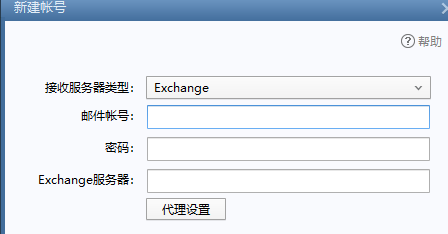微软exchange邮箱发送
使用java发送exchange类型的邮件,foxmail中配置如下图:

需要的maven依赖如下:
<dependency><groupId>com.microsoft.ews-java-api</groupId><artifactId>ews-java-api</artifactId><version>2.0</version>
</dependency>
<dependency><groupId>org.projectlombok</groupId><artifactId>lombok</artifactId><optional>true</optional>
</dependency>配置文件email.properties内容如下:
# Exchange邮箱配置
email.exchange.username=发件人邮箱
email.exchange.password=发件人邮箱密码
email.exchange.server=邮箱服务器地址工具类代码如下:
package com.utils;import lombok.extern.slf4j.Slf4j;
import microsoft.exchange.webservices.data.core.ExchangeService;
import microsoft.exchange.webservices.data.core.enumeration.misc.ExchangeVersion;
import microsoft.exchange.webservices.data.core.exception.service.local.ServiceLocalException;
import microsoft.exchange.webservices.data.core.service.item.EmailMessage;
import microsoft.exchange.webservices.data.credential.ExchangeCredentials;
import microsoft.exchange.webservices.data.credential.WebCredentials;
import microsoft.exchange.webservices.data.property.complex.MessageBody;import java.io.IOException;
import java.io.InputStream;
import java.net.URI;
import java.net.URISyntaxException;
import java.util.ArrayList;
import java.util.Arrays;
import java.util.List;
import java.util.Properties;@Slf4j
public class ExchangeClient {private static final Properties PROPERTIES = new Properties();static {try {loadProperties();} catch (IOException e) {e.printStackTrace();}}private static void loadProperties() throws IOException {try (InputStream input = ExchangeClient.class.getClassLoader().getResourceAsStream("email.properties")) {PROPERTIES.load(input);}}private static String getProperty(String key) {return PROPERTIES.getProperty(key);}private final String hostname = getProperty("email.exchange.server");private final String username = getProperty("email.exchange.username");private final String password = getProperty("email.exchange.password");private final ExchangeVersion exchangeVersion;private final String domain;private final String subject;private final String recipientTo;private final List<String> recipientCc;private final List<String> recipientBcc;private final List<String> attachments;private final String message;private ExchangeClient(ExchangeClientBuilder builder) {this.exchangeVersion = builder.exchangeVersion;this.domain = builder.domain;this.subject = builder.subject;this.recipientTo = builder.recipientTo;this.recipientCc = builder.recipientCc;this.recipientBcc = builder.recipientBcc;this.attachments = builder.attachments;this.message = builder.message;}public static class ExchangeClientBuilder {private String hostname;private ExchangeVersion exchangeVersion;private String domain;private String username;private String password;private String subject;private String recipientTo;private List<String> recipientCc;private List<String> recipientBcc;private List<String> attachments;private String message;public ExchangeClientBuilder() {this.exchangeVersion = ExchangeVersion.Exchange2010_SP1;this.hostname = "";this.username = "";this.password = "";this.subject = "";this.recipientTo = "";this.recipientCc = new ArrayList<>(0);this.recipientBcc = new ArrayList<>(0);this.attachments = new ArrayList<>(0);this.message = "";}/*** The hostname of the Exchange Web Service. It will be used for* connecting with URI https://hostname/ews/exchange.asmx** @param hostname the hostname of the MS Exchange Smtp Server.* @return the builder for chain usage.*/public ExchangeClientBuilder hostname(String hostname) {this.hostname = hostname;return this;}/*** The Exchange Web Server version.** @param exchangeVersion the Exchange Web Server version.* @return the builder for chain usage.*/public ExchangeClientBuilder exchangeVersion(ExchangeVersion exchangeVersion) {this.exchangeVersion = exchangeVersion;return this;}/*** The domain of the MS Exchange Smtp Server.** @param domain the domain of the Active Directory. The first part of* the username. For example: MYDOMAIN\\username, set the MYDOMAIN.* @return the builder for chain usage.*/public ExchangeClientBuilder domain(String domain) {this.domain = domain;return this;}/*** The username of the MS Exchange Smtp Server. The second part of the* username. For example: MYDOMAIN\\username, set the username.** @param username the username of the MS Exchange Smtp Server.* @return the builder for chain usage.*/public ExchangeClientBuilder username(String username) {this.username = username;return this;}/*** The password of the MS Exchange Smtp Server.** @param password the password of the MS Exchange Smtp Server.* @return the builder for chain usage.*/public ExchangeClientBuilder password(String password) {this.password = password;return this;}/*** The subject for this send.** @param subject the subject for this send.* @return the builder for chain usage.*/public ExchangeClientBuilder subject(String subject) {this.subject = subject;return this;}/*** The recipient for this send.** @param recipientTo the recipient for this send.* @return the builder for chain usage.*/public ExchangeClientBuilder recipientTo(String recipientTo) {this.recipientTo = recipientTo;return this;}/*** You can specify one or more email address that will be used as cc* recipients.** @param recipientCc the first cc email address.* @param recipientsCc the other cc email address for this send.* @return the builder for chain usage.*/public ExchangeClientBuilder recipientCc(String recipientCc, String... recipientsCc) {// Prepare the list.List<String> recipients = new ArrayList<>(1 + recipientsCc.length);recipients.add(recipientCc);recipients.addAll(Arrays.asList(recipientsCc));// Set the list.this.recipientCc = recipients;return this;}/*** You can specify a list with email addresses that will be used as cc* for this email send.** @param recipientCc the list with email addresses that will be used as* cc for this email send.* @return the builder for chain usage.*/public ExchangeClientBuilder recipientCc(List<String> recipientCc) {this.recipientCc = recipientCc;return this;}/*** You can specify one or more email address that will be used as bcc* recipients.** @param recipientBcc the first bcc email address.* @param recipientsBcc the other bcc email address for this send.* @return the builder for chain usage.*/public ExchangeClientBuilder recipientBcc(String recipientBcc, String... recipientsBcc) {// Prepare the list.List<String> recipients = new ArrayList<>(1 + recipientsBcc.length);recipients.add(recipientBcc);recipients.addAll(Arrays.asList(recipientsBcc));// Set the list.this.recipientBcc = recipients;return this;}/*** You can specify a list with email addresses that will be used as bcc* for this email send.** @param recipientBcc the list with email addresses that will be used* as bcc for this email send.* @return the builder for chain usage.*/public ExchangeClientBuilder recipientBcc(List<String> recipientBcc) {this.recipientBcc = recipientBcc;return this;}/*** You can specify one or more email address that will be used as cc* recipients.** @param attachment the first attachment.* @param attachments the other attachments for this send.* @return the builder for chain usage.*/public ExchangeClientBuilder attachments(String attachment, String... attachments) {// Prepare the list.List<String> attachmentsToUse = new ArrayList<>(1 + attachments.length);attachmentsToUse.add(attachment);attachmentsToUse.addAll(Arrays.asList(attachments));// Set the list.this.attachments = attachmentsToUse;return this;}/*** You can specify a list with email attachments that will be used for* this email send.** @param attachments the list with email attachments that will be used* for this email send.* @return the builder for chain usage.*/public ExchangeClientBuilder attachments(List<String> attachments) {this.attachments = attachments;return this;}/*** The body of the email message.** @param message the body of the email message.* @return the builder for chain usage.*/public ExchangeClientBuilder message(String message) {this.message = message;return this;}/*** Build a mail.** @return an EmailApacheUtils object.*/public ExchangeClient build() {return new ExchangeClient(this);}}public boolean sendExchange() {// The Exchange Server Version.ExchangeService exchangeService = new ExchangeService(exchangeVersion);// Credentials to sign in the MS Exchange Server.ExchangeCredentials exchangeCredentials = new WebCredentials(username, password, domain);exchangeService.setCredentials(exchangeCredentials);// URL of exchange web service for the mailbox.try {exchangeService.setUrl(new URI("https://" + hostname + "/ews/Exchange.asmx"));} catch (URISyntaxException ex) {log.info("An exception occured while creating the uri for exchange service.", ex);return false;}// The email.EmailMessage emailMessage;try {emailMessage = new EmailMessage(exchangeService);emailMessage.setSubject(subject);emailMessage.setBody(MessageBody.getMessageBodyFromText(message));} catch (Exception ex) {log.info("An exception occured while setting the email message.", ex);return false;}// TO recipient.try {emailMessage.getToRecipients().add(recipientTo);} catch (ServiceLocalException ex) {log.info("An exception occured while sstting the TO recipient(" + recipientTo + ").", ex);return false;}// CC recipient.for (String recipient : recipientCc) {try {emailMessage.getCcRecipients().add(recipient);} catch (ServiceLocalException ex) {log.info("An exception occured while sstting the CC recipient(" + recipient + ").", ex);return false;}}// BCC recipientfor (String recipient : recipientBcc) {try {emailMessage.getBccRecipients().add(recipient);} catch (ServiceLocalException ex) {log.info("An exception occured while sstting the BCC recipient(" + recipient + ").", ex);return false;}}// Attachements.for (String attachmentPath : attachments) {try {emailMessage.getAttachments().addFileAttachment(attachmentPath);} catch (ServiceLocalException ex) {log.info("An exception occured while setting the attachment.", ex);return false;}}try {emailMessage.send();log.info("An email is send.");} catch (Exception ex) {log.info("An exception occured while sending an email.", ex);return false;}return true;}}
调用代码如下:
public static void main(String[] args) {ExchangeClient exchangeClient = new ExchangeClient.ExchangeClientBuilder().exchangeVersion(ExchangeVersion.Exchange2010).recipientTo("收件人邮箱").recipientCc("抄送人邮箱1", "抄送人邮箱2").recipientBcc("密送人邮箱").subject("邮件主题").message("邮件内容").build();boolean sendExchange = exchangeClient.sendExchange();System.err.println("send result:" + sendExchange);}